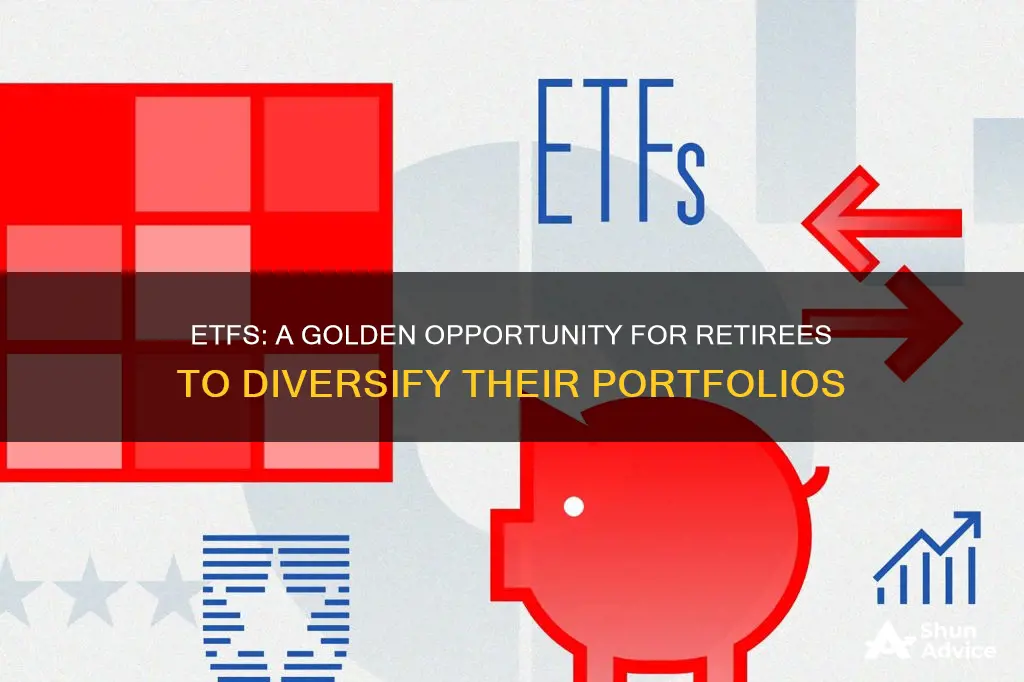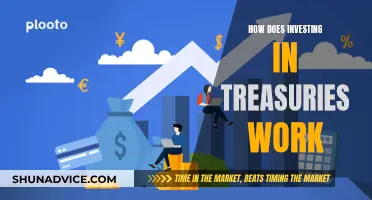
Exchange-traded funds (ETFs) are a good investment for retirees because they are simple, diversified, tax-efficient, and have low expenses. They can provide retirees with short-term income generation and long-term growth. ETFs are also beneficial for retirees because they are easy to manage and allow for cash flow extraction. However, it's important to note that ETFs are not risk-free, and there may be times when they produce negative returns.
| Characteristics | Values |
|---|---|
| Income generation | ETFs can provide supplemental income for retirees. |
| Long-term growth potential | Growth ETFs can be important for retirees as they may live for 20+ years after retirement. |
| Simplicity | It's generally easier to build an ETF portfolio than a portfolio of individual stocks and bonds. |
| Diversification | ETFs can provide exposure to hundreds of stocks or other assets in one packaged security. |
| Low expenses | ETFs have lower expense ratios than mutual funds, translating to higher returns in the long run. |
| Tax efficiency | ETFs can manage investment inflows and outflows by creating or redeeming "creation units", increasing tax efficiency. |
| Risk | ETFs are not risk-free investments and can produce negative returns. |
| Lack of control | ETF investors cannot choose the stocks or bonds held in the fund. |
What You'll Learn

Simplicity and low expenses
ETFs are a good investment for retirees because they are simple, have low expense ratios, and provide higher returns in the long run.
Simplicity
ETFs are simple to understand and invest in. They are a hybrid of stocks and mutual funds, trading like the former and functioning like the latter. This means that they are easy to buy and sell, and they provide exposure to hundreds of stocks or other assets in one packaged security.
For retirees, this means that they can accomplish their investment goals with a relatively small set of ETFs, whether it is diversification of assets, income, growth, or a combination of these objectives.
Low Expenses
ETFs have much lower expense ratios than mutual funds. The expense ratio is the cost of running the fund, which is taken out of the ETF's assets and lowers the return for investors. The lower the expense ratio, the lower the cost of fund ownership.
Lower expenses for ETFs ensure that more dividends and interest flow through to retirement accounts, which is important when living on a fixed income. This is especially beneficial for retirees, as they can hold more cash and bonds, which tend to lower a portfolio's return potential.
Additionally, ETFs are tax-efficient, as they can manage investment inflows and outflows by creating or redeeming "creation units". They also have low turnover, meaning minimal buying and selling of securities, which minimizes capital gains taxes for retired investors with taxable accounts.
Examples of Low-Cost ETFs
Some examples of low-cost ETFs include:
- IShares Core S&P 500 ETF (IVV)
- Vanguard S&P 500 ETF (VOO)
- SPDR Portfolio S&P 500 ETF (SPLG)
- Vanguard Total Bond Market ETF
- IShares Core U.S. Aggregate Bond ETF
- Vanguard Total Stock Market ETF
The NFT Investment Craze: Why?
You may want to see also

Tax efficiency
ETFs are generally considered more tax-efficient than mutual funds. This is because they typically have fewer "taxable events" and fewer capital gains distributions, which results in fewer opportunities for taxation.
Taxable Events
From the perspective of the IRS, the tax treatment of ETFs and mutual funds is the same. Both are subject to capital gains tax and taxation of dividend income. However, ETFs are structured in a way that minimises taxes for the holder.
A mutual fund manager must constantly rebalance the fund by selling securities to accommodate shareholder redemptions or to reallocate assets. The sale of securities within the mutual fund portfolio creates capital gains for the shareholders, even for those who may have an unrealized loss on the overall mutual fund investment.
In contrast, an ETF manager accommodates investment inflows and outflows by creating or redeeming "creation units", which are baskets of assets that approximate the entirety of the ETF investment exposure. As a result, the investor is usually not exposed to capital gains on any individual security in the underlying structure.
Capital Gains Distributions
Comprehensively, ETFs don't often have capital gains distributions, which makes them more tax-efficient than mutual funds. This is because ETFs use creation units that allow for the purchase and sale of assets in the fund collectively. This means that ETFs usually don't generate the capital gains distributions that mutual funds do and, therefore, don't see the tax effects of those distributions.
Dividends
Dividends can be another type of income from ETFs. Dividends will usually be separated into qualified and non-qualified (ordinary), which each have different tax rates. ETF dividends are taxed according to how long the investor has owned the ETF fund. If the investor has held the fund for more than 60 days before the dividend was issued, the dividend is considered a "qualified dividend" and is taxed anywhere from 0% to 20% depending on the investor's income tax rate. If the dividend was held for less than 60 days before being issued, then the dividend income is taxed at the investor's ordinary income tax rate.
Retirement Accounts
There can also be some tax exceptions for both ETFs and mutual funds held in retirement accounts, as these are typically tax-advantaged accounts.
Fidelity Investments: College Tuition Support for Employees
You may want to see also

Income generation
One of the primary purposes of investments in retirement is to generate supplemental income. Income-generating investments for retirees include dividend-paying stocks and interest-paying bonds. Exchange-traded funds (ETFs) can be a good source of income for retirees as they offer exposure to stocks and bonds.
Stock ETFs pay dividends, while bond ETFs pay interest to shareholders. Dividend-focused ETFs typically invest in stocks of companies that pay high or stable and growing dividends. These funds aim to provide a steady income stream through regular dividend distributions.
Some examples of dividend ETFs suitable for retirees include:
- IShares Core High Dividend ETF (HDV) - focuses on high dividend-yielding US companies with a five-year annualized return of 7.4%.
- Vanguard High Dividend Yield ETF (VYM) - a conservative way to remain in stocks during retirement, sacrificing potential price growth for more substantial income generation.
- SPDR S&P Dividend ETF (SDY) - has a 30-day SEC yield of 2.6% and a similar 12-month yield.
Bond ETFs, also known as fixed-income ETFs, provide interest payments to shareholders. These ETFs typically track an index of bonds, such as the Lehman Brothers US Aggregate Bond Index.
An example of a suitable bond ETF for retirees is:
IShares U.S. Treasury Bond ETF (GOVT) - focuses on U.S. Treasury bonds, which are considered low-risk investments due to the backing of the US government. This ETF provides a steady income stream through coupon payments.
In addition to income generation, ETFs offer other benefits for retirees, such as low costs, tax efficiency, and diversification. However, it is important to consider both the pros and cons of investing in ETFs for retirement and to construct a portfolio that aligns with an individual's financial goals and risk tolerance.
The Smart Money Move: Pay Off Debt or Invest?
You may want to see also

Long-term growth potential
One of the primary purposes of investments in retirement is to produce supplemental income. As people are generally living longer, growth ETFs can be an important part of long-term investing. For periods of 10 years or longer, ETFs that track the performance of a broad market index, such as the S&P 500, have outperformed most actively managed portfolios that invest similarly.
ETFs are exchange-traded funds that hold other investment assets, such as stocks or bonds. Most ETFs passively track the performance of a benchmark index, such as the S&P 500. They are a hybrid of stocks and mutual funds. Like stocks, they trade intra-day on an exchange, and like mutual funds, they are pooled securities.
Growth ETFs are portfolios of growth stocks. A growth stock is any company with an above-average growth profile. In other words, these are companies whose revenue and earnings are expanding faster than the market average. They also often pay little or no dividends, instead choosing to reinvest their cash flow to maintain their growth.
Growth ETFs make a lot of sense because they allow you to diversify your growth-stock holdings through a fund, protecting your downside. They also tend to be cheap, efficient vehicles that allow you to invest in dozens, if not hundreds, of growth stocks without having to trade them all individually.
- Vanguard Russell 1000 Growth ETF (VONG)
- Vanguard U.S. Momentum Factor ETF (VFMO)
- Vanguard Small-Cap Growth ETF (VBK)
- Vanguard Growth ETF (VUG)
- IShares S&P 500 Growth ETF (IVW)
- Invesco QQQ ETF (QQQ)
Retirement Planning: Navigating the Investment Divide
You may want to see also

Risk and lack of control
While ETFs offer many benefits to retirees, there are also some potential drawbacks to consider, such as risk and lack of control.
ETFs are not risk-free investments, and even a diversified portfolio can experience negative returns. For example, in 2022 and early 2023, most stock and bond ETFs saw declines due to inflation and rising interest rates. However, certain types of ETFs, such as floating-rate bond ETFs and covered-call ETFs, performed well during this period, providing income for investors.
It's important to remember that investing in the stock market always carries some level of risk, and there are no guarantees of positive returns. Retirees should carefully consider their risk tolerance and financial goals before investing in ETFs or any other type of investment.
One of the key differences between investing in individual securities and ETFs is the level of control. With individual stocks or bonds, investors have the flexibility to choose specific companies or industries to include in their portfolio. They can tailor their investments to align with their values, interests, or specific sectors they believe will perform well.
However, with ETFs, investors do not have the same level of control over the underlying assets. ETF investors are purchasing a basket of securities that are predetermined by the fund manager, following a specific index, or focusing on a particular sector. While this can provide the benefit of diversification, it may not allow for the same level of customization as choosing individual securities.
Additionally, the performance of an ETF is dependent on the overall market or sector it is tracking. If the market or sector experiences a downturn, the ETF will likely be impacted. In contrast, a carefully curated portfolio of individual stocks or bonds may provide more opportunities to mitigate losses by adjusting the allocation or choosing specific companies with stronger performance.
Lack of control also extends to the timing of buying and selling. With individual securities, investors can time their purchases and sales based on their own research and market conditions. They can take advantage of buying opportunities when prices are low and sell when they believe a stock has peaked. However, with ETFs, investors are buying into a fund that is continuously purchasing and selling assets based on the underlying index or strategy. The timing of these transactions is determined by the fund manager, and individual ETF investors may not have the same level of flexibility to time their trades optimally.
In conclusion, while ETFs offer many advantages to retirees, it's important to consider the potential risks and the lack of control inherent in this type of investment. Retirees should carefully evaluate their financial goals, risk tolerance, and the level of customization they desire before deciding whether to include ETFs in their investment portfolio.
Retirement Planning: Navigating Investment Options for Your Golden Years
You may want to see also
Frequently asked questions
ETFs, or exchange-traded funds, are a good investment for retirees as they are tax-efficient, low-cost, and low-maintenance. They are also good for income generation and long-term growth.
ETFs are not risk-free and can produce negative returns. There is also a lack of control over the stocks and bonds held in the ETF.
Some of the best ETFs for retirees include the SPDR S&P 500 ETF Trust, the Vanguard Growth ETF, and the iShares Russell 2000 ETF. The Vanguard Total Bond Market ETF and the iShares Cohen & Steers REIT ETF are also good options for retirees.







